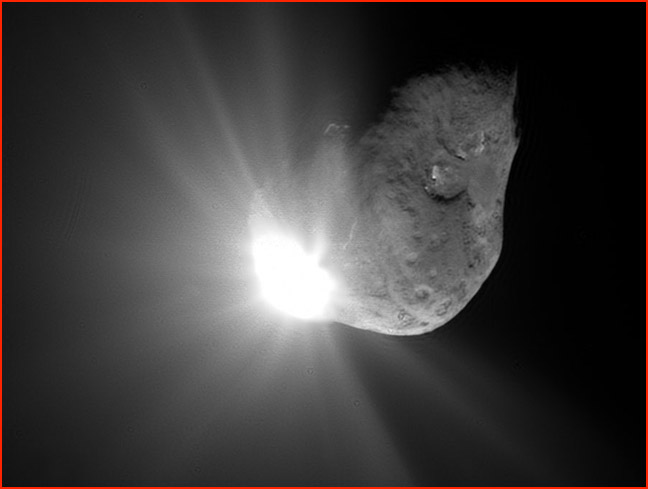|
THUNDERBOLTS PICTURE OF THE DAY |
||
 Credit: NASA |
||
|
Jul 15, 2005 We have long suggested that, after Deep Impact, scientists would be scratching their heads over the lack of subsurface water - the last hope of the dirty snowball theory. Early results confirm this prediction. Early in the morning of July 3, we registered our predictions for Deep Impact (July 4), when a widely heralded "impactor" would strike the nucleus of Comet Tempel 1. We presented these predictions based on the electric comet hypothesis as interpreted by Wallace Thornhill and other members of the Thunderbolts crew. To the best of our knowledge, we set forth the most specific and detailed scientific predictions offered by any group in anticipation of the event. We stated our purpose explicitly? "With the imminent arrival of the 'Deep Impact' spacecraft at the comet Tempel 1, it is time to test competing theories on the nature of comets. The predictions and lines of reasoning offered here will set the stage for future analysis of the 'electric comet' model". It has now been almost two weeks since we posted these predictions, and the Deep Impact investigative team has made it clear that it could be many weeks before an analysis of certain crucial details will be released. Yet information already disclosed provides a good sense as to how well the electric comet model has performed against the "dirty snowball" model of popular theory. In this and following Pictures of the Day we shall begin an analysis of specific results. We stated: "An abundance of water on or below the surface of the nucleus (the underlying assumption of the 'dirty snowball' hypothesis) is unlikely". Though this was never a deal killer for the electric model, the absence of sufficient water in a comet is a deal killer for the dirty snowball model. We wrote: "In fact none of the electrical theorists will be surprised if the impactor exposes a subsurface with little or no ices". In a July 8 press release, the Harvard-Smithsonian Center for Astrophysics summarized the early findings with the headline, "Deep Impact Was a Dust-up, Not a Gusher". Smithsonian astronomers had monitored the impact using the ground-based Submillimeter Array (SMA) in Hawaii and NASA's orbiting Submillimeter Wave Astronomy Satellite (SWAS). Early reports showed "only weak emission from water vapor and a host of other gases that were expected to erupt from the impact site. The most conspicuous feature of the blast was brightening due to sunlight scattered by the ejected dust". This was not what they had expected by any means. "It's pretty clear that this event did not produce a gusher," said SWAS principal investigator Gary Melnick of the Harvard-Smithsonian Center for Astrophysics (CfA). "The more optimistic predictions for water output from the impact haven't materialized, at least not yet." Astronomer Charlie Qi (CfA) also expressed surprise at these results. "Theories about the volatile layers below the surface of short-period comets are going to have to be revised," Qi said. Was he raising a question about the underlying model here? No, he was only "deepening" the contradictions. The impact result, he said, "indicates that these effects [presence of water] could be much deeper." So the crisis for standard comet theory grows. Proponents of the dirty snowball model had already been forced into an untenable position by prior discoveries of dry comet surfaces. So they began to speculate about water buried beneath the surfaces - a speculation that only increased the difficulty for models having to explain why observed ices in the Jovian and Saturnian system do not produce explosive jets while comets at the same distances do. Only recently, some astronomers abandoned the phrase "dirty snowballs" and began calling comets "icy dirtballs". The dirt, they said, was on the surface, and the water was underneath. Strangely, this shift in theory was never accompanied by any attempt to reckon with the problems inherent in placing an insulating layer around ice which, even when directly exposed to the Sun (as on the planet Mars at Tempel's distance from the Sun) does not behave the way their models required. It was hoped that Deep Impact would show that sufficient water existed beneath the surface. By excavating material from the comet's interior, they could rescue the theory. But it didn't happen. "SWAS operators were puzzled by the lack of increased water vapor from Tempel 1". In fact there was no change in measured water after the impact. Another observation from the Odin telescope in Sweden found that the total amount of water appeared to decrease after the impact, probably because of the injection of quantities of dry dust. But still, hope remained. Qi speculated that the comet might become more active over the following days and weeks. "We're still hoping for a big outgassing from the new active area created by Deep Impact", he said. But the electrical theorists predict this will not happen. As we wrote in our July 3 predictions, "Most comets should be homogeneous - their interiors will have the same composition as their surfaces". So far, the data returned have consistently fulfilled this prediction. Periodic outbursts are common, but emissions suggesting hidden water or other volatiles beneath the surface have not occurred. It needs to be understood, however, that in the electric model changes in coma composition are certain to occur in the wake of substantial ejections. This is guaranteed by the electrical transaction between the coma and the solar wind. And here too the data released so far strongly support the electric model, as we shall observe in our next Picture of the Day. See also: |
|
|
Copyright 2005: thunderbolts.info |
||
